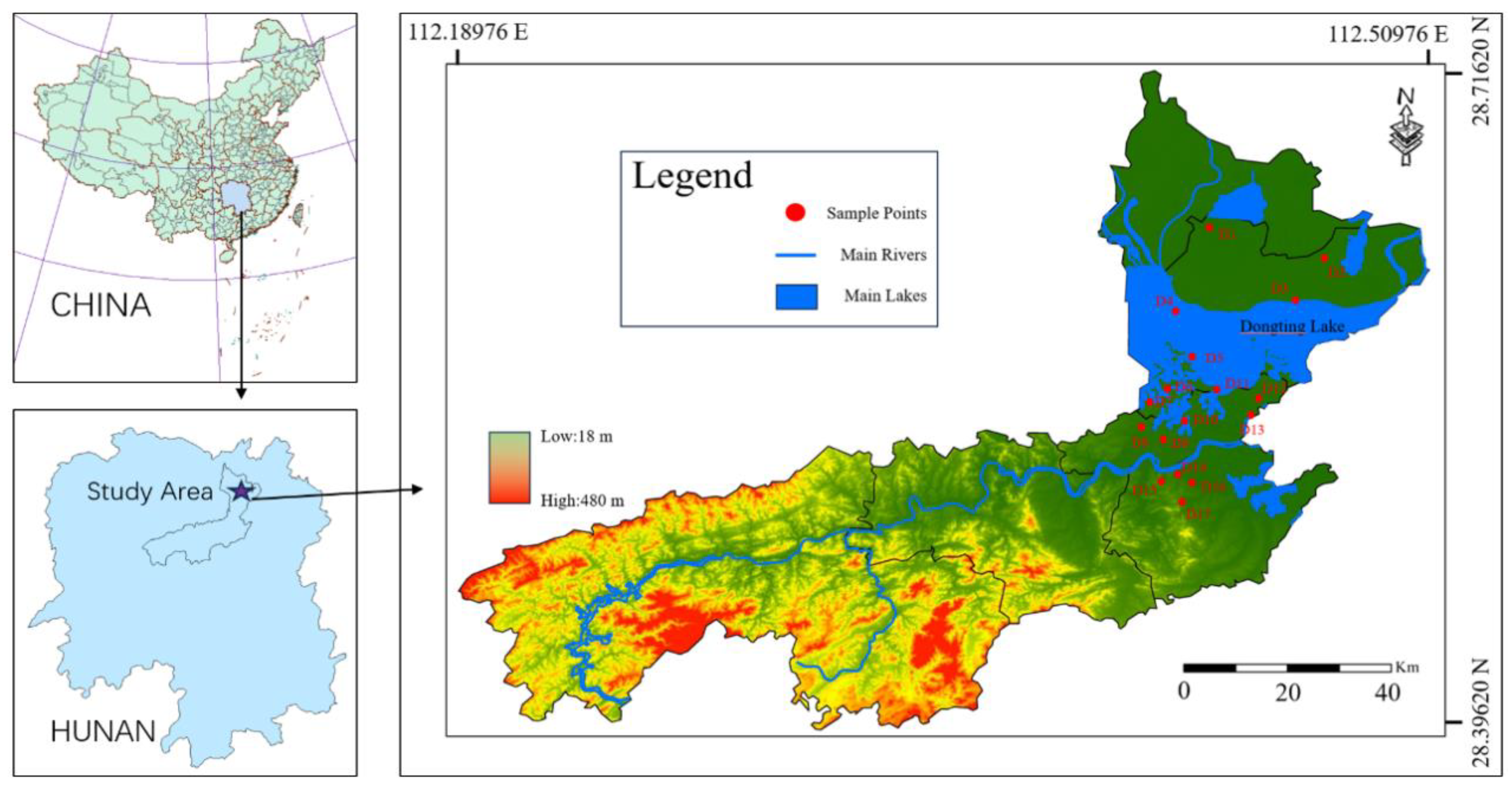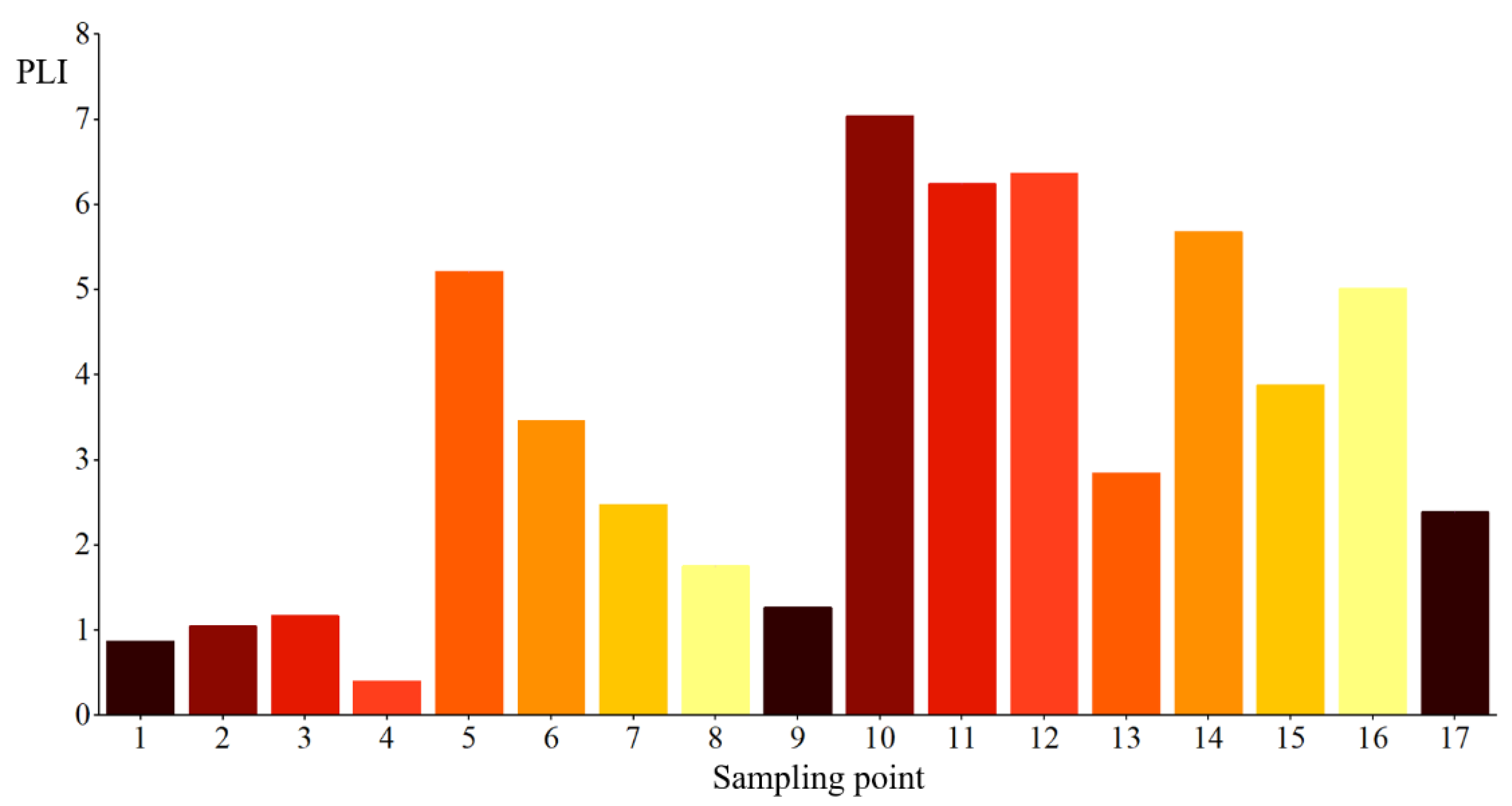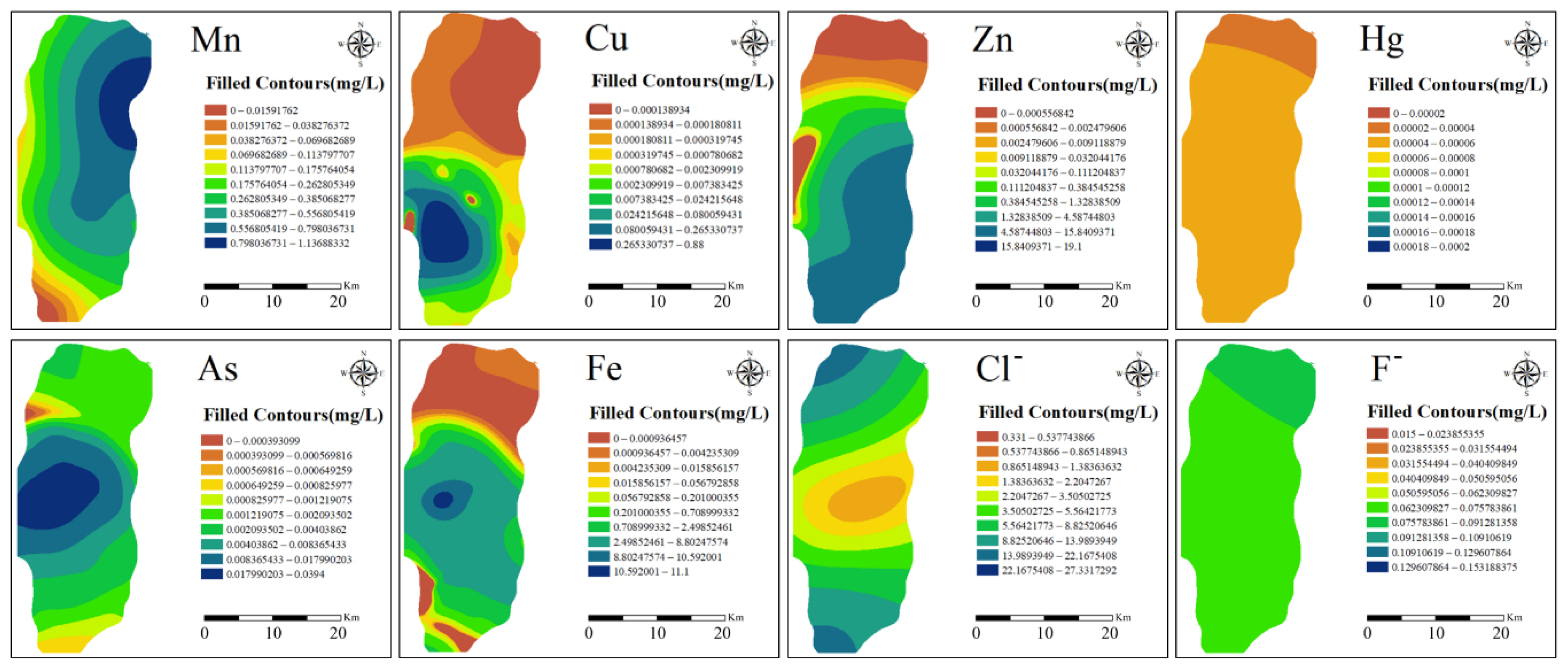Study on Pollution Characteristics, Sources, and Health Risks of Potentially Toxic Elements in Groundwater of Dongting Lake Basin, China
Abstract
1. Introduction
2. Materials and Methods
2.1. Study Area Overview
2.2. Sample Collection and Analysis
2.3. Groundwater Pollution Assessment
2.3.1. Geo-Accumulation Index (Igeo)
2.3.2. Pollution Load Index (PLI)
2.4. Groundwater Pollution Prediction
2.4.1. Inverse Distance Weighting (IDW)
2.4.2. Ordinary Kriging (OK)
2.4.3. Model Validation
2.5. Groundwater Source Analysis
2.5.1. Self-Organizing Maps (SOM)
2.5.2. Principal Component Analysis (PCA)
2.6. Health Risk Assessment Model
2.6.1. Non-Carcinogenic Risk
2.6.2. Carcinogenic Risk
2.7. Data Processing
3. Results and Discussion
3.1. PTE Pollution Levels in Groundwater
3.2. Spatial Distribution Characteristics of Groundwater PTEs Pollution
3.3. Sources of Groundwater PTE Pollution
3.4. Health Risks of Groundwater PTEs Pollution
4. Conclusions
Supplementary Materials
Author Contributions
Funding
Institutional Review Board Statement
Informed Consent Statement
Data Availability Statement
Acknowledgments
Conflicts of Interest
References
- Xing, L.; Guo, H.; Zhan, Y. Groundwater hydrochemical characteristics and processes along flow paths in the North China Plain. J. Asian Earth Sci. 2013, 70–71, 250–264. [Google Scholar] [CrossRef]
- Kaur, M.; Kumar, A.; Mehra, R.; Kaur, I. Quantitative assessment of exposure of heavy metals in groundwater and soil on human health in Reasi district, Jammu and Kashmir. Environ. Geochem. Health 2020, 42, 77–94. [Google Scholar] [CrossRef] [PubMed]
- Zahedi, S.; Azarnivand, A.; Chitsaz, N. Groundwater quality classification derivation using Multi-Criteria-Decision-Making techniques. Ecol. Indic. 2017, 78, 243–252. [Google Scholar] [CrossRef]
- Tang, L.; Deng, S.; Tan, D.; Long, J.; Lei, M. Heavy metal distribution, translocation, and human health risk assessment in the soil-rice system around Dongting Lake area, China. Environ. Sci. Pollut. Res. 2019, 26, 17655–17665. [Google Scholar] [CrossRef]
- Li, F.; Huang, J.; Zeng, G.; Yuan, X.; Li, X.; Liang, J.; Wang, X.; Tang, X.; Bai, B. Spatial risk assessment and sources identification of heavy metals in surface sediments from the Dongting Lake, Middle China. J. Geochem. Explor. 2013, 132, 75–83. [Google Scholar] [CrossRef]
- Zhong, L.; Liu, L.; Yang, J. Characterization of heavy metal pollution in the paddy soils of Xiangyin County, Dongting lake drainage basin, central south China. Environ. Earth Sci. 2012, 67, 2261–2268. [Google Scholar] [CrossRef]
- Zou, H.; Ren, B. Analyzing topsoil heavy metal pollution sources and ecological risks around antimony mine waste sites by a joint methodology. Ecol. Indic. 2023, 154, 110761. [Google Scholar] [CrossRef]
- Prasad, B.; Bose, J. Evaluation of the heavy metal pollution index for surface and spring water near a limestone mining area of the lower Himalayas. Environ. Geol. 2001, 41, 183–188. [Google Scholar] [CrossRef]
- Saleh, H.N.; Panahande, M.; Yousefi, M.; Asghari, F.B.; Conti, G.O.; Talaee, E.; Mohammadi, A.A. Carcinogenic and Non-carcinogenic Risk Assessment of Heavy Metals in Groundwater Wells in Neyshabur Plain, Iran. Biol. Trace Elem. Res. 2019, 190, 251–261. [Google Scholar] [CrossRef]
- Chen, L.; Ren, B.; Deng, X.; Yin, W.; Xie, Q.; Cai, Z. Potential toxic heavy metals in village rainwater runoff of antimony mining area, China: Distribution, pollution sources, and risk assessment. Sci. Total. Environ. 2024, 920, 170702. [Google Scholar] [CrossRef]
- Wang, T.; Wang, Z.; Shi, J.; Yin, Y.; Du, W.; Wu, J.; Guo, H. A green sulfidated micro zero-valent iron based-hydrogel for the synergistic removal of heavy metal cations and anions in groundwater. Sci. Total. Environ. 2025, 972, 179096. [Google Scholar] [CrossRef] [PubMed]
- Adeyemi, A.A.; Ojekunle, Z.O. Concentrations and health risk assessment of industrial heavy metals pollution in groundwater in Ogun state, Nigeria. Sci. Afr. 2021, 11, e00666. [Google Scholar] [CrossRef]
- Anwar, M.; Shirazi, S.A.; Mazhar, U. Spatial Distribution and Health Risk Assessment of Groundwater Pollution in Kotlakhpat Industrial Complex, Lahore. Water Air Soil Pollut. 2024, 235, 157. [Google Scholar] [CrossRef]
- Bhutiani, R.; Kulkarni, D.B.; Khanna, D.R.; Gautam, A. Geochemical distribution and environmental risk assessment of heavy metals in groundwater of an industrial area and its surroundings, Haridwar, India. Energy Ecol. Environ. 2017, 2, 155–167. [Google Scholar] [CrossRef]
- Wagh, V.M.; Panaskar, D.B.; Mukate, S.V.; Gaikwad, S.K.; Muley, A.A.; Varade, A.M. Health risk assessment of heavy metal contamination in groundwater of Kadava River Basin, Nashik, India. Model. Earth Syst. Environ. 2018, 4, 969–980. [Google Scholar] [CrossRef]
- Zou, H.; Ren, B.; Deng, X.; Li, T. Geographic distribution, source analysis, and ecological risk assessment of PTEs in the topsoil of different land uses around the antimony tailings tank: A case study of Longwangchi tailings pond, Hunan, China. Ecol. Indic. 2023, 150, 110205. [Google Scholar] [CrossRef]
- Zou, H.; Li, W.-Q.; Ren, B.-Z.; Xie, Q.; Cai, Z.-Q.; Chen, L.-Y.; Wang, J. Heavy metal pollution and ecological risk assessment: A study on Linli County soils based on self-organizing map and positive factorization approaches. J. Cent. South Univ. 2024, 31, 1371–1382. [Google Scholar] [CrossRef]
- Yao, Z.; Bao, Z.; Zhou, L.; Gao, P. A statistical approach for determining the environment impact of surface sediments from the Dongting Lake area, central China. Chin. J. Geochem. 2009, 28, 97–104. [Google Scholar] [CrossRef]
- Yao, Z. Comparison between BCR sequential extraction and geo-accumulation method to evaluate metal mobility in sediments of Dongting Lake, Central China. Chin. J. Oceanol. Limnol. 2008, 26, 14–22. [Google Scholar] [CrossRef]
- Makokha, V.A.; Qi, Y.; Shen, Y.; Wang, J. Concentrations, Distribution, and Ecological Risk Assessment of Heavy Metals in the East Dongting and Honghu Lake, China. Expo. Health 2016, 8, 31–41. [Google Scholar] [CrossRef]
- Chen, L.; Ren, B.; Deng, X.; Yin, W.; Xie, Q.; Cai, Z.; Zou, H. Black shale bedrock control of soil heavy metal typical high geological background in China Loushao Basin: Pollution characteristics, source and Influence assessment based on spatial analysis. J. Hazard. Mater. 2024, 477, 135072. [Google Scholar] [CrossRef] [PubMed]
- Peng, D.; Liu, Z.; Su, X.; Xiao, Y.; Wang, Y.; Middleton, B.A.; Lei, T. Correction: Spatial distribution of heavy metals in the West Dongting Lake floodplain, China. Environ. Sci. Process. Impacts 2020, 22, 1306. [Google Scholar] [CrossRef] [PubMed]
- Hao, W.; Liu, H.; Hao, S.; Mao, K. Characterization of heavy metal contamination in groundwater of typical mining area in Hunan Province. Sci. Rep. 2024, 14, 13054. [Google Scholar] [CrossRef] [PubMed]
- Jiang, Z.; Guo, Z.; Peng, C.; Liu, X.; Zhou, Z.; Xiao, X. Heavy metals in soils around non-ferrous smelteries in China: Status, health risks and control measures. Environ. Pollut. 2021, 282, 117038. [Google Scholar] [CrossRef]
- Xie, Q.; Ren, B.; Shi, X.; Hursthouse, A. Factors on the distribution, migration, and leaching of potential toxic metals in the soil and risk assessment around the zinc smelter. Ecol. Indic. 2022, 144, 109502. [Google Scholar] [CrossRef]
- Eyankware, M.O.; Akakuru, O.C.; Osisanya, W.O.; Umayah, S.O.; Ukor, K.P. Assessment of heavy metal pollution on groundwater quality in the Niger Delta Region of Nigeria. Sustain. Water Resour. Manag. 2023, 9, 189. [Google Scholar] [CrossRef]
- Goix, S.; Resongles, E.; Point, D.; Oliva, P.; Duprey, J.L.; de la Galvez, E.; Ugarte, L.; Huayta, C.; Prunier, J.; Zouiten, C.; et al. Transplantation of epiphytic bioaccumulators (Tillandsia capillaris) for high spatial resolution biomonitoring of trace elements and point sources deconvolution in a complex mining/smelting urban context. Atmos. Environ. 2013, 80, 330–341. [Google Scholar] [CrossRef]
- Haldar, K.; Kujawa-Roeleveld, K.; Dey, P.; Bosu, S.; Datta, D.K.; Rijnaarts, H.H. Spatio-temporal variations in chemical-physical water quality parameters influencing water reuse for irrigated agriculture in tropical urbanized deltas. Sci. Total. Environ. 2020, 708, 134559. [Google Scholar] [CrossRef]
- Yin, S.Q.; Wang, Z.; Zhu, Z.; Zou, X.K.; Wang, W.T. Using Kriging with a heterogeneous measurement error to improve the accuracy of extreme precipitation return level estimation. J. Hydrol. 2018, 562, 518–529. [Google Scholar] [CrossRef]
- Kebonye, N.M.; Eze, P.N.; John, K.; Gholizadeh, A.; Dajčl, J.; Drábek, O.; Němeček, K.; Borůvka, L. Self-organizing map artificial neural networks and sequential Gaussian simulation technique for mapping potentially toxic element hotspots in polluted mining soils. J. Geochem. Explor. 2021, 222, 106680. [Google Scholar] [CrossRef]
- Li, T.; Sun, G.; Yang, C.; Liang, K.; Ma, S.; Huang, L. Using self-organizing map for coastal water quality classification: Towards a better understanding of patterns and processes. Sci. Total Environ. 2018, 628–629, 1446–1459. [Google Scholar] [CrossRef] [PubMed]
- Liao, X.; Tao, H.; Gong, X.; Li, Y. Exploring the database of a soil environmental survey using a geo-self-organizing map: A pilot study. J. Geogr. Sci. 2019, 29, 1610–1624. [Google Scholar] [CrossRef]
- Jiang, F.; Ren, B.; Hursthouse, A.; Deng, R.; Wang, Z. Distribution, source identification, and ecological-health risks of potentially toxic elements (PTEs) in soil of thallium mine area (southwestern Guizhou, China). Environ. Sci. Pollut. Res. 2019, 26, 16556–16567. [Google Scholar] [CrossRef] [PubMed]
- Ravindra, K.; Mor, S. Distribution and health risk assessment of arsenic and selected heavy metals in Groundwater of Chandigarh, India. Environ. Pollut. 2019, 250, 820–830. [Google Scholar] [CrossRef]
- Ferreira-Baptista, L.; De Miguel, E. Geochemistry and risk assessment of street dust in Luanda, Angola: A tropical urban environment. Atmos. Environ. 2005, 39, 4501–4512. [Google Scholar] [CrossRef]
- Baghaie, A.H.; Aghili, F. Health risk assessment of Pb and Cd in soil, wheat, and barley in Shazand County, central of Iran. J. Environ. Heal. Sci. Eng. 2019, 17, 467–477. [Google Scholar] [CrossRef]
- Deng, Y.; Jiang, L.; Xu, L.; Hao, X.; Zhang, S.; Xu, M.; Zhu, P.; Fu, S.; Liang, Y.; Yin, H.; et al. Spatial distribution and risk assessment of heavy metals in contaminated paddy fields—A case study in Xiangtan City, southern China. Ecotoxicol. Environ. Saf. 2019, 171, 281–289. [Google Scholar] [CrossRef]
- Lin, S.; Zhang, P.; Xu, Y.; Yuan, Y.; Hui, K.; Su, J.; Tan, W. Seasonal variations in health risks associated with nitrates and heavy metals in groundwater: A case study of typical regions along the riverside plain in China. Process Saf. Environ. Prot. 2025, 196, 106949. [Google Scholar] [CrossRef]
- Jiang, C.; Yin, L.; Wen, X.; Du, C.; Wu, L.; Long, Y.; Liu, Y.; Ma, Y.; Yin, Q.; Zhou, Z.; et al. Microplastics in Sediment and Surface Water of West Dongting Lake and South Dongting Lake: Abundance, Source and Composition. Int. J. Environ. Res. Public Health 2018, 15, 2164. [Google Scholar] [CrossRef]
- Xiao, P.; Wan, J.; Cheng, J.; Wang, X.; Zhao, X. Study on Hydrochemical Characteristics and Interactions between Groundwater and Surface Water in the Dongting Lake Plain. Water 2024, 16, 964. [Google Scholar] [CrossRef]
- Chen, J.; Taniguchi, M.; Liu, G.; Miyaoka, K.; Onodera, S.-I.; Tokunaga, T.; Fukushima, Y. Nitrate pollution of groundwater in the Yellow River delta, China. Hydrogeol. J. 2007, 15, 1605–1614. [Google Scholar] [CrossRef]
- Masood, N.; Batool, S.; Farooqi, A. Chapter 22—Groundwater pollution in Pakistan. In Global Groundwater; Mukherjee, A., Scanlon, B.R., Aureli, A., Langan, S., Guo, H., McKenzie, A.A., Eds.; Elsevier: Amsterdam, The Netherlands, 2021; pp. 309–322. [Google Scholar] [CrossRef]
- Wu, H.; Xu, C.; Wang, J.; Xiang, Y.; Ren, M.; Qie, H.; Zhang, Y.; Yao, R.; Li, L.; Lin, A. Health risk assessment based on source identification of heavy metals: A case study of Beiyun River, China. Ecotoxicol. Environ. Saf. 2021, 213, 112046. [Google Scholar] [CrossRef] [PubMed]
- Yin, X.; Yan, G.; Wang, X.; Zheng, B. Trends and risk assessment of heavy metals in the surface sediments of river-connected lakes: A case study of Dongting Lake. Mar. Pollut. Bull. 2024, 209, 117181. [Google Scholar] [CrossRef] [PubMed]
- Xue, S.; Wang, Y.; Jiang, J.; Tang, L.; Xie, Y.; Gao, W.; Tan, X.; Zeng, J. Groundwater heavy metal(loid)s risk prediction based on topsoil contamination and aquifer vulnerability at a zinc smelting site. Environ. Pollut. 2024, 341, 122939. [Google Scholar] [CrossRef]
- Chen, H.; Teng, Y.; Lu, S.; Wang, Y.; Wang, J. Contamination features and health risk of soil heavy metals in China. Sci. Total Environ. 2015, 512–513, 143–153. [Google Scholar] [CrossRef]
- White, P.D.; Van Leeuwen, P.; Davis, B.D.; Maddaloni, M.; A Hogan, K.; Marcus, A.H.; Elias, R.W. The conceptual structure of the integrated exposure uptake biokinetic model for lead in children. Environ. Heal. Perspect. 1998, 106, 1513–1530. [Google Scholar] [CrossRef]







| PTEs | Min | Max | Mean | S.D | CV | Background Value |
|---|---|---|---|---|---|---|
| Mn Cu Zn Hg As Fe Cl− F− | 0 0 0 0 0 0 0.47 0.03 | 1.14 0.88 0.15 0.0002 0.04 3.51 27.3 0.15 | 0.286 0.05 0.018 0.00005 0.006 0.6 5.83 0.073 | 0.36 0.21 0.045 0.000048 0.01 1.1 8.94 0.044 | 1.24 4.07 2.45 1.15 1.76 1.83 1.53 0.6 | 0.01 0.003 0.001 0.0001 0.001 0.05 2 0.1 |
| Principal Component | Eigenvalue | Contribution Rate (%) | Cumulative Rate (%) |
|---|---|---|---|
| 1 | 3.82 | 28.6 | 28.6 |
| 2 | 1.56 | 18.6 | 47.2 |
| 3 | 1.02 | 16.0 | 63.2 |
| Adult | Child | |||
|---|---|---|---|---|
| Elements | HQingest | HI | HQingest | HI |
| Mn | 5.44 × 10−5 | 5.44 × 10−5 | 4.35 × 10−4 | 4.35 × 10−4 |
| Cu | 3.56 × 10−5 | 3.56 × 10−5 | 2.85 × 10−4 | 2.85 × 10−4 |
| Zn | 3.49 × 10−4 | 3.49 × 10−4 | 2.79 × 10−3 | 2.79 × 10−3 |
| Hg | 3.73 × 10−6 | 3.73 × 10−6 | 2.98 × 10−5 | 2.98 × 10−5 |
| As | 5 × 10−4 | 5 × 10−4 | 4.01 × 10−3 | 4.01 × 10−3 |
| Fe | 1.52 × 10−4 | 1.52 × 10−4 | 1.21 × 10−3 | 1.21 × 10−3 |
| Cl− | 1.49 × 10−5 | 1.49 × 10−5 | 1.19 × 10−4 | 1.19 × 10−4 |
| F− | 3.82 × 10−5 | 3.82 × 10−5 | 3.06 × 10−4 | 3.06 × 10−4 |
| Total | 1.15 × 10−3 | 1.15 × 10−3 | 9.18 × 10−3 | 9.18 × 10−3 |
Disclaimer/Publisher’s Note: The statements, opinions and data contained in all publications are solely those of the individual author(s) and contributor(s) and not of MDPI and/or the editor(s). MDPI and/or the editor(s) disclaim responsibility for any injury to people or property resulting from any ideas, methods, instructions or products referred to in the content. |
© 2025 by the authors. Licensee MDPI, Basel, Switzerland. This article is an open access article distributed under the terms and conditions of the Creative Commons Attribution (CC BY) license (https://creativecommons.org/licenses/by/4.0/).
Share and Cite
Deng, X.; Zou, H.; Ren, B.; Wang, J.; Chen, L. Study on Pollution Characteristics, Sources, and Health Risks of Potentially Toxic Elements in Groundwater of Dongting Lake Basin, China. Sustainability 2025, 17, 3554. https://doi.org/10.3390/su17083554
Deng X, Zou H, Ren B, Wang J, Chen L. Study on Pollution Characteristics, Sources, and Health Risks of Potentially Toxic Elements in Groundwater of Dongting Lake Basin, China. Sustainability. 2025; 17(8):3554. https://doi.org/10.3390/su17083554
Chicago/Turabian StyleDeng, Xinping, Hao Zou, Bozhi Ren, Jin Wang, and Luyuan Chen. 2025. "Study on Pollution Characteristics, Sources, and Health Risks of Potentially Toxic Elements in Groundwater of Dongting Lake Basin, China" Sustainability 17, no. 8: 3554. https://doi.org/10.3390/su17083554
APA StyleDeng, X., Zou, H., Ren, B., Wang, J., & Chen, L. (2025). Study on Pollution Characteristics, Sources, and Health Risks of Potentially Toxic Elements in Groundwater of Dongting Lake Basin, China. Sustainability, 17(8), 3554. https://doi.org/10.3390/su17083554






